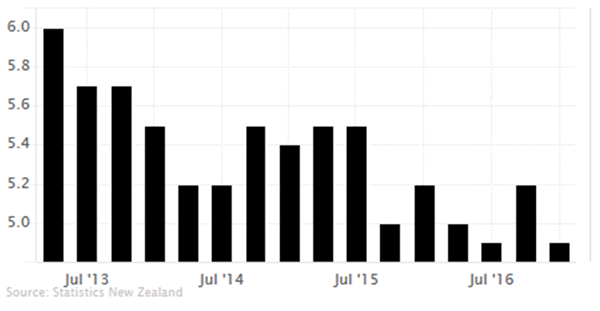Summary:
- In the quarter ending March 2017, New Zealand’s unemployment fell to 4.9%
- The decline in the unemployment suggested stronger than expected job growth
- It is estimated that over 29,000 workers entered the workforce in the quarter ending March 2017
- New Zealand’s labor participation rate continued to rise to 70.6% marking a record high
New Zealand’s quarterly unemployment rate fell to 4.9% in the March 2017 quarter which reversed the increase from the previous quarterly unemployment rate of 5.2%. The drop in the unemployment rate came on firm job growth.
Data released by Statistics New Zealand last week showed that the employment rose by 1.2% over the quarter, with 29k workers entering the workforce. This was a strong jobs growth, higher than what was anticipated.
The labor force increased by 23k during the quarter ending March 2017 which came as the growth in the economy attracted more workers into the labor market. Further adding weight to this was the strong levels of migration as well which continued to attract workers, strengthening the labor force as a result.

New Zealand unemployment rate: 4.9%, Q1 2017
Combined, the above factors led to a consistent increase in the labor participation rate which rose to 70.6% and marked a record increase, up 0.1 percentage points from the previous quarter.
Most of the job gains came from part-time jobs which rose 3.1% on the quarter whereas full time jobs rose only 0.6%. Industry-wise, job gains were seen coming from hospitality and services sectors including accommodation and good services. The construction sector was also seen contributing to the labor market growth.
Despite the strong numbers, surprisingly the average hours worked fell 0.6% in the quarter following a strong increase in the previous quarter. Alongside the decline in average hours worked, wage inflation was also absent.
The prospects of the labor market in New Zealand continued to remain strong, according to the Quarterly Survey of Employment. Data showed that firms expect to see a modest pace of employment growth. Full time employment is expected to rise 0.4% while the filled jobs rose 0.3% on the quarter.
While labour demand continued to strengthen, this has not yet translated into stronger nominal wage growth. The private sector LCI index rose 0.4% in the quarter, leaving annual inflation on this measure at 1.5% (in line with expectations). Similarly, the broader QES measure of average hourly earnings rose 0.3% over the quarter.
RBNZ expected to keep OCR unchanged
The unemployment report was indeed a surprising report especially for policy makers on the stronger than expected jobs growth, but still, there is strong evidence of broad softness in the data especially when it comes to wage growth and unemployment rate.
However, in a separate report, the New Zealand job ads showed a 2.8% jump in April as the monthly growth continued to accelerate. Job ads were up 18% from a year ago in April suggesting that the underlying factors in the labor market continued to build up.
The Reserve Bank of New Zealand will be meeting this week on Wednesday and policymakers are unlikely to make any changes to their statement while also leaving the overnight cash rate unchanged at 1.75%. The markets are expecting the first rate hike from the RBNZ to come only next year, in 2018 currently.
However, that could change should inflation continue to rise in the coming quarters while on the unemployment front; wage inflation will remain a key component in assessing the pace of future rate hikes. While no changes to the OCR is expected this week, the RBNZ could remain neutral which could bode well for the New Zealand dollar in the short term.














